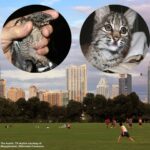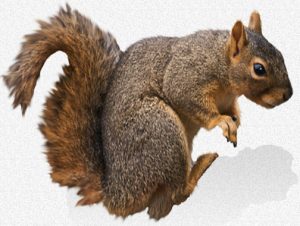Raising Orphan Fox Squirrels
Ron Hines, DVM PhD
 All Of Dr. Hines’ Other Wildlife Rehab Articles
All Of Dr. Hines’ Other Wildlife Rehab Articles
Orphaned wildlife tend to knock more than once on the door of a kind- hearted person So, for nestling birds, go here. opossums, here , raccoons, here. Cottontail rabbits, here.Turtles here. Bobcats and other such creatures are best left to professionals for them, go here. Squirrels do not require vaccinations. That does not mean they cannot occasionally spread diseases. Be clean. To see what other wildlife receive in the way of vaccinations, click on the ark 
Dear Reader,
My suggestions are based on my personal experience raising squirrels. However many experienced wildlife rehabilitators have very different advice that they tend to be quite adamant about. Like all commercial animal diets, there is no guarantee that formulas will not have ingredient differences batch to batch. But that so many techniques work well, is a tribute to the toughness and adaptability of these little rodents, God bless them:
“Dr Hines:
I am a federal and state permitted wild life rehabilitator in Texas, just recently, I read about your suggestions about raising baby squirrels, and I have to say that in my experience (11 years raising between 60 to 180 orphaned a year) my milk of preference has been always Esbilac™ (puppy formula) through the years I ventured to try the fox valley formula for squirrels in which the animal did not developed as well as with the puppy milk, and for the KMR™ is proven to cause MBD in squirrels. EVER time that someone had brought me an infant raised with this kind of milk was because they started having problems. KMR™ is great for raccoons and kittens but in my experience absolutely NOT good for squirrels. Sincerely yours and thank you for your time.
Squirrel Litters:
Squirrel litters vary from two to five in number, and average three. If the nest tree has been cut down, check the hole very carefully because it is easy to miss small youngsters. Spring birthing time varies according to the area of the United States you live in and there is great variation within a given region. Most breeding occurs from December to February and May through June. The winter litter is generally smaller than the summer litter. Squirrels are considered low-risk for the transmission of rabies, but it is good idea for everyone who deal with wildlife to receive the immunizations.
When found, baby squirrels are often dehydrated, chilled and weak. These problems must be addressed before they will nurse or have the ability to digest formula. If you pinch the skin at the nape of the neck and it doesn’t spring back flat but remains tented, fluid, such as lactated ringers solution is best given subcutaneously at about 10% of the infant�s weight at three hour intervals. You can try oral Pedialyte™ in small amounts if injections are not possible.
A low-setting heating pad under one side of a cardboard or plastic container lined with Kleenex, paper towels or cellulose fiber makes a good initial home. I also put together a 14″ x 10″ plastic basin in which I have a 40 watt light bulb within a small tin can. This serves as an excellent surrogate mother. You can also find 10 watt refrigerator bulbs at Wall-Mart that can be placed in a soup can for similar effect. Usually, the service person at the electrical and lamp supply area of Home Depot or Lowes will rig up the cord and fittings if you bring your own screwdrivers. I have never had these can-warmers catch fire or scald the infants but I suppose such a thing could happen.
Purchase an aquarium thermometer and keep the temperature at 95-100F with enough space for the babies to find their own optimal temperature. If the infant’s eyes are open, the main housing container will have to be secured on top with a porous mesh so the baby does not escape. If you own cats, be sure to do this.
Keep the container out of drafts and away from small children. The less you handle the babies other than to feed them, the better. I bundle them in a soft face washcloth to feed them so as not to soil them or spread bacteria from my hands. Red squirrels are the smallest, so the amounts fed need to be reduced accordingly.
I generally mix the formula slightly thicker than suggested on the label after the baby has done well for the first 2-3 days. Most powdered infant animal formulas suggest one part powder to two parts water. This is fine during initial feedings when rehydration is important and the babies are adjusting to the new diet. But as they adjust, you can go to one part powder to about one-and-a-half parts distilled water.
I mix only the amount I will use during a single feeding or during a day, depending on the availability of a refrigerator and general sanitation in the nursery. Freezing formula causes the emulsions to separate and clump but does not seem to affect the nutrient value. Since it looks unpleasant when thawed, I only do that if I have large numbers of baby squirrels to care for. I generally use KMR™ or Hartz kitten formula™, but other Folks do well using Esbilac™ and other brands.
I use a polystyrene 1 ml disposable pipette drawn out thin at the end with a flame as a nursing bottle. With practice, slight pressure on the bulb will supply the liquid at the end at just the right speed and volume. Later, I may feed them from one-half ounce plastic “Yorker” bottles with a small hole punched in the red cap with a hot 25-gauge needle.
I stimulate their urination and defecation after each feeding with a moistened pledget of cotton being careful not to irritate their tender behinds. If they do become red and inflamed do to this or to diarrhea, I massage the area with a drop of one of the many triamcinolone/bacitracin/neomycin antibiotic creams available at veterinarians. Wall-Mart sells the tube for $4.00 but you will probably need a prescription.
How Much Do I Feed In A Single Feeding?
There is considerable controversy as to how much to feed a baby squirrel. Many experienced squirrel rehabilitators feed 5% of body weight and are happy with the squirrels they eventually release. Some sub-species, such as fox squirrels in Florida, are smaller and so require a bit less formula. Babies with little fur or no fur are the most fragile. The skin on their tummy is translucent, so you can see their white stomach when it is full of milk. I, personally, feed them until their stomach is fully outlined. Going beyond that causes regurgitation (upchuck) that eventually leads to pneumonia and death.
Experienced rehabilitators argue about what and how much to feed all the time. They recommend what works best for them but there are many regimens that produce healthy, releasable offspring. Those of you who have raised your own children know that healthy kids are the product of many cultures and family eating practices. It is also quite untrue that a fat squirrel is a healthy squirrel – just as a fat child is not a healthy child. . I tend to feed a more concentrated, energy-rich formula than others so the amount I feed is proportionately less.
Whatever amount you decide to feed, use your common sense. After feeding, the baby, it should be relaxed with a slight plumpness to its abdomen but not a full, bloated pear-shaped appearance. You are always safer feeding less than an animal will willingly eat. This goes for any animal. Not only are you less likely to cause digestive disturbances, pneumonia, bloating and diarrhea but you will produce a more vigorous, alert and energetic young squirrel. One that is less likely to fall prey to the dangers of the outside world when you are ready to release it. And one with an immune system capable of fighting off the diseases it encounters.
Overfeeding wild babies is a major problem. It is our natural instinct to overfeed little critters. It leads to obesity, liver and kidney disease, abnormal sugar metabolism and a host of other problems that shorten a squirrel’s life span. In livestock , overeating was recognized as a cause of sudden death over a hundred years ago. Also, many years ago, studies on rats and mice found that caloric restriction (approximately 40%) increased life span approximately 25%. Infant rats fed forty percent less, matured slower with stronger bones, ligaments and muscles. Throughout their life spans, the incidence of common diseases was decreased significantly. Please remember that my advice represents only my own personal experiences as a veterinarian raising squirrels. Many small feeding during the day are much safer than fewer but larger feeding.
Very small babies, weighing less than 10 grams (less than a week old, pink, blind, naked, toothless) should be dropper- fed about every one to two hours. Once they are stabilized, rosy pink, warm to the touch with good muscle tone, they can be fed between 0.1 and 0.4 cc (ml) per feeding. This comes out to about two to six drops of formula every one to two hours.
During the second two weeks, twenty gram infants will accept 0.4 to 0.8 ml of formula. It is better to underfeed them a bit than overfeed them during this period.
Three to five-week-old babies (ears have opened) should accept 1.5 to 2.5 ml of formula per feeding and the number of feedings per day can be reduced to six.
Six to ten week old infants (eyes open) will accept 2.5 to 6.0 ml of formula per feeding and the number of feedings can be reduced to four or five.
Thirteen to twenty-week old babies will drink up to 10 ml of formula given four times a day and are fully independent.
During this period, they should be placed in a large, natural cage, introduced to solid foods (berries, nuts, grains, fresh corn, sprouts, insects – as wide a variety as you can) even though mother squirrels nurse their infants up to four months.
A shallow crock provides water. The less you handle them, the more wild and releasable they will become.
14 to 16 weeks is a good age to release them. You can leave the cage door ajar so they can return for food.
Some Problems You Might Encounter:
 If an uninformed caregiver has been feeding the infant a diet low in calcium and/or vitamin D3, such as pabulum, the squirrel may have soft, rubbery legs, which bow outward at the knees (rickets). They are also more susceptible to cross-bite. (ref) This is called metabolic bone disease. Cataracts sometimes accompany it. You can stop this process with proper diet but you cannot completely reverse the damage that has already occurred. In its severe form, the squirrel can never be released.
If an uninformed caregiver has been feeding the infant a diet low in calcium and/or vitamin D3, such as pabulum, the squirrel may have soft, rubbery legs, which bow outward at the knees (rickets). They are also more susceptible to cross-bite. (ref) This is called metabolic bone disease. Cataracts sometimes accompany it. You can stop this process with proper diet but you cannot completely reverse the damage that has already occurred. In its severe form, the squirrel can never be released.
 Baby squirrels love to suck – sometimes on embarrassing places. A little bitter apple on those areas may help. Or, soak a piece of cotton cord or twine in formula and let them satisfy their urge that way. Tie a knot in the end large enough so that they can’t swallow the cord.
Baby squirrels love to suck – sometimes on embarrassing places. A little bitter apple on those areas may help. Or, soak a piece of cotton cord or twine in formula and let them satisfy their urge that way. Tie a knot in the end large enough so that they can’t swallow the cord.
 Some litters become scabby due to skin parasites. Ivermectin, given orally at 200 micrograms/kg is safe and effective against all skin parasites. A local veterinarian or feed store, needs to supply this. A less effective remedy is a light dusting with cube resin (derris root) powder, used for organic gardening. Fleas are uncommon in rural squirrels but common in urban ones. They are best picked off manually.
Some litters become scabby due to skin parasites. Ivermectin, given orally at 200 micrograms/kg is safe and effective against all skin parasites. A local veterinarian or feed store, needs to supply this. A less effective remedy is a light dusting with cube resin (derris root) powder, used for organic gardening. Fleas are uncommon in rural squirrels but common in urban ones. They are best picked off manually.
 Diarrhea is common when infant squirrels are fed too much, too fast, or cow’s milk. Other causes are sour milk, unsanitary conditions, bacterial transfer from your hands, or a star-crossed, weak litter. Antibiotics may be helpful, but decreasing the concentration of the formula and feeding smaller amounts more frequently interspersed with Pedialyte feedings usually does the trick.
Diarrhea is common when infant squirrels are fed too much, too fast, or cow’s milk. Other causes are sour milk, unsanitary conditions, bacterial transfer from your hands, or a star-crossed, weak litter. Antibiotics may be helpful, but decreasing the concentration of the formula and feeding smaller amounts more frequently interspersed with Pedialyte feedings usually does the trick.
 Internal parasites are possible but a very uncommon cause of diarrhea. Squirrels tolerate small doses (drops) of kaopectate well as well as bismuth subsalicylate anti-diarrheal cattle suspension. If this is insufficient, antibiotics such as neomycin (20mg/kg tid =three times a day) or cephalexin (50mg/kg bid) might be helpful.
Internal parasites are possible but a very uncommon cause of diarrhea. Squirrels tolerate small doses (drops) of kaopectate well as well as bismuth subsalicylate anti-diarrheal cattle suspension. If this is insufficient, antibiotics such as neomycin (20mg/kg tid =three times a day) or cephalexin (50mg/kg bid) might be helpful.
 Baby squirrels often develop distended, bloated stomachs due to eating too much and too fast. This is usually the result of too infrequent feedings or a dropper that delivers the formula too fast. One needs to greatly reduce the concentration of the formula given or feed straight Pedialyte when this occurs.
Baby squirrels often develop distended, bloated stomachs due to eating too much and too fast. This is usually the result of too infrequent feedings or a dropper that delivers the formula too fast. One needs to greatly reduce the concentration of the formula given or feed straight Pedialyte when this occurs.
Massaging the gas gently from the tummy his helpful. So is a drop of dioctyl sodium sulfosuccinate (Colase™-type stool softener and cattle bloat remedy) given every two hours. Occasionally, the problem will respond to a drop of Metoclopramide (10mg/ml) syrup given every two hours or so. Bloated baby squirrels often have concurrent aspiration pneumonia. Formula should never exit the nose. Remember, underfeeding a bit is much safer than giving the baby all the formula that it will accept.
You are on the Vetspace animal health website


